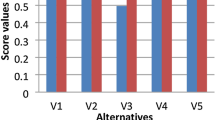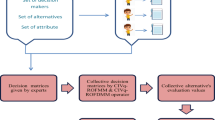Abstract
q-rung orthopair fuzzy set (q-ROFS) is a useful tool to express uncertain information. With the parameter q increasing, q-ROFSs have broader space for describing uncertain information than intuitionistic fuzzy sets (IFSs) and Pythagorean fuzzy sets (PFSs). This paper extends the superiority and inferiority ranking (SIR) methods to solve multiple attribute decision making (MADM) problems within the q-ROF environment, named q-ROF-SIR methods. In the q-ROF-SIR methods, the possibility degree (PD) for q-rung orthopair fuzzy numbers (q-ROFNs) is introduced to improve the preference intensity. Further, the q-ROF entropy weight (q-ROF-EW) method is constructed to determine the attribute weights suppose the weights of attribute are unknown. Finally, the effectiveness and applicability of the q-ROF-SIR methods are verified.





Similar content being viewed by others
References
Bellman R, Zadeh L (1970) Decision-making in a fuzzy environment. Manage Sci 17:141–164
Atanassov K (1986) Intuitionistic fuzzy sets. Fuzzy Sets Syst 20:87–96
Yager RR (2014) Pythagorean membership grades in multicriteria decision making. IEEE Trans Fuzzy Syst 22:958–965
Yager RR (2017) Generalized orthopair fuzzy sets. IEEE Trans Fuzzy Syst 25:1222–1230
Liu P, Wang P (2017) Some q-rung orthopair fuzzy aggregation operators and their applications to multiple-attribute decision making. Int J Intell Syst 33:259–280
Liu P, Chen S, Wang P (2018) Multiple-attribute group decision-making based on q-rung orthopair fuzzy power maclaurin symmetric mean operators. IEEE Trans Syst Man Cybern Syst 50(10):3741–3756. https://doi.org/10.1109/TSMC.2018.2852948
Liu P, Liu J (2018) Some q-rung orthopai fuzzy bonferroni mean operators and their application to multi-attribute group decision making. Int J Intell Syst 33:315–347
Liu P, Cheng S, Zhang Y (2019) An extended multi-criteria group decision-making promethee method based on probability multi-valued neutrosophic sets. Int J Fuzzy Syst 21:388–406
Pinar A, Boran FE (2020) A q-rung orthopair fuzzy multi-criteria group decision making method for supplier selection based on a novel distance measure. Int J Mach Learn Cybern 11:1749–1780
Wei G, Gao H, Wei Y (2018) Some q-rung orthopair fuzzy heronian mean operators in multiple attribute decision making. Int J Intell Syst 33:1426–1458
Xu X (2001) The SIR method: a superiority and inferiority ranking method for multiple criteria decision making. Eur J Oper Res 131:587–602
Brans JP, Mareschal B, Vincke P (1984) PROMETHEE: a new family of outranking methods in multicriteria analysis. In: Brans JP (ed) Operational research ’84. North-Holland, Amsterdam
Brans JP, Vincke P (1985) The promethee method for multiple criteria decision-making. Manage Sci 31:647–656
Marzouk M (2008) A superiority and inferiority ranking model for contractor selection. Constr Innov 8:250–268
Memariani A, Amini A, Alinezhad A (2009) Sensitivity analysis of simple additive weighting method (SAW): the results of change in the weight of one attribute on the final ranking of alternatives. J Ind Eng 4:13–18
Ma ZJ, Zhang N, Ying D (2014) A novel SIR method for multiple attributes group decision making problem under hesitant fuzzy environment. J Intell Fuzzy Syst 26:2119–2130
Peng X, Yong Y (2015) Some results for pythagorean fuzzy sets. Int J Intell Syst 30:1133–1160
Papathanasiou J, Ploskas N (2018) Multiple criteria decision aid methods, examples and python implementations. Springer International Publishing AG, part of Springer Nature. Chapter 4: 91–108
Brans JP, Mareschal B (1992) Promethee-V-MCDM problems with segmentation constraints. INFOR 30:85–96
Brans JP, Mareschal B (1995) The promethee vi procedure: how to differentiate hard from soft multicriteria problems. J Decis Syst 4:213–223
Brans JP, Mareschal B (2005) Promethee methods, multiple criteria decision analysis: state of the art surveys. Springer, New York
Dias LC, Costa JP, Clímaco JN (1998) A parallel implementation of the promethee method. Eur J Oper Res 104:521–531
Chen TY (2014) A PROMETHEE-based outranking method for multiple criteria decision analysis with interval type-2 fuzzy sets. Soft Comput 18:923–940
Chen TY (2015) An interval type-2 fuzzy PROMETHEE method using a likelihood-based outranking comparison approach. Inf Fusion 25:105–120
Li WX, Li BY (2010) An extension of the PROMETHEE II method based on generalized fuzzy numbers. Expert Syst Appl 37:5314–5319
Liao HC, Xu ZS (2014) Multi-criteria decision making with intuitionistic fuzzy promethee. J Intell Fuzzy Syst 27:1703–1717
Yilmaz B, Daǧdeviren M (2011) A combined approach for equipment selection: F-promethee method and zero-one goal programming. Expert Syst Appl 38:11641–11650
Ziemba P (2018) Neat F-PROMETHEE—a new fuzzy multiple criteria decision making method based on the adjustment of mapping trapezoidal fuzzy numbers. Expert Syst Appl 110:363–380
Zhao J, Zhu H, Li H (2019) 2-Dimension linguistic PROMETHEE methods for multiple attribute decision making. Expert Syst Appl 127:97–108
Zhu H, Zhao J, Xu Y (2016) 2-Dimension linguistic computational model with 2-tuples for multi-attribute group decision making. Knowl Based Syst 103:132–142
De Luca A, Termini S (1972) A definition of a nonprobabilistic entropy in the setting of fuzzy sets theory. Inf Control 20:301–312
Yager RR (1979) On the measure of fuzziness and negation part I: membership in the unit interval. Int J Gen Syst 5:221–229
Kosko B (1986) Fuzzy entropy and conditioning. Inf Sci 40:165–174
Liu X (1992) Entropy, distance measure and similarity measure of fuzzy sets and their relations. Fuzzy Sets Syst 52:305–318
Fan JL, Ma YL (2002) Some new fuzzy entropy formulas. Fuzzy Sets Syst 128:277–284
Burillo P, Bustince H (1996) Entropy on intuitionistic fuzzy sets and on interval-valued fuzzy sets. Fuzzy Sets Syst 78:305–316
Szmidt E, Kacprzyk J (2001) Entropy for intuitionistic fuzzy sets. Fuzzy Sets Syst 118:467–477
Ioannis K, George D (2006) Inner product based entropy in the intuitionistic fuzzy setting. Int J Uncertain Fuzziness Knowl Based Syst 14:351–366
Huang G (2007) A new fuzzy entropy for intuitionistic fuzzy sets. In: International conference on fuzzy systems & knowledge discovery
Xia M, Xu Z (2012) Entropy/cross entropy-based group decision making under intuitionistic fuzzy environment. Inf Fusion 13:31–47
Guo K, Song Q (2014) On the entropy for Atanassovs intuitionistic fuzzy sets: an interpretation from the perspective of amount of knowledge. Appl Soft Comput 24:328–340
Hussain Z, Yang M-S (2018) Entropy for hesitant fuzzy sets based on Hausdorff metric with construction of hesitant fuzzy topsis. Int J Fuzzy Syst 20:2517–2533
Yang M-S, Hussain Z (2018) Fuzzy entropy for pythagorean fuzzy sets with application to multicriterion decision making. Complexity 2018:1–14
Xue W, Xu Z, Zhang X, Tian X (2018) Pythagorean fuzzy LINMAP method based on the entropy theory for railway project investment decision making. Int J Intell Syst 33:93–125
Xu Z, Da L (2003) Possibility degree method for ranking interval numbers and its application. J Syst Eng 18:67–70
Wei C, Tang X (2010) Possibility degree method for ranking intuitionistic fuzzy numbers. In: 3rd IEEE/WIC/ACM international conference on web intelligence and intelligent agent technology (WI-IAT’10), pp 142–145
Wan S, Dong J (2014) A possibility degree method for interval-valued intuitionistic fuzzy multi-attribute group decision making. J Comput Syst Sci 80:237–256
Gao F (2013) Possibility degree and comprehensive priority of interval numbers. Syst Eng Theory Pract 33:2033–2040
Dammak F, Baccour L, Alimi A (2016) An exhaustive study of possibility measures of interval-valued intuitionistic fuzzy sets and application to multicriteria decision making. Adv Fuzzy Syst 10:1–10
Zhang X, Xu Z (2014) Extension of topsis to multiple criteria decision making with pythagorean fuzzy sets. Int J Intell Syst 29:1061–1078
Zadeh L (1968) Probability measures of fuzzy events. J Math Anal Appl 23:421–427
Acknowledgements
This work is partially supported by the Natural Science Foundation of China (Grant No. 61673320). The authors also gratefully acknowledge the helpful comments and suggestions of the reviewers.
Author information
Authors and Affiliations
Corresponding author
Additional information
Publisher's Note
Springer Nature remains neutral with regard to jurisdictional claims in published maps and institutional affiliations.
Rights and permissions
About this article
Cite this article
Zhu, H., Zhao, J. & Li, H. q-ROF-SIR methods and their applications to multiple attribute decision making. Int. J. Mach. Learn. & Cyber. 13, 595–607 (2022). https://doi.org/10.1007/s13042-020-01267-4
Received:
Accepted:
Published:
Issue Date:
DOI: https://doi.org/10.1007/s13042-020-01267-4




